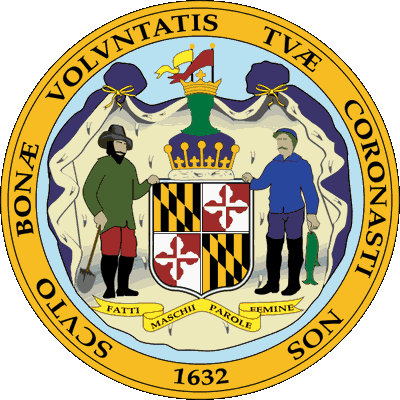- » 50 States »
- » Histories »
- » State Symbols »
- » Mottos
Maryland State Motto
"Fatti Maschii Parole Femine"

(manly deeds, womanly words) or (strong deeds, gentle words)
Adopted in 1776.
Language: Italian
Focus: Religious
See Maryland State Seal
The Maryland motto, Fatti Maschii Parole Femine, has not specifically been adopted as a state motto. Rather, it has been accepted as a state motto because it was adopted as an element of the Maryland State Seal by the Convention of 1776 1776.
The motto and arms of the Calvert family appear on the reverse of Maryland's state seal.
Maryland State Motto
"Fatti Maschii Parole Femine"
Reflecting its English colonial origin, the seal shows a ribbon with Fatti machii parole femine (Manly deeds, womanly words.) The state motto variably appears in unofficial versions above and below the main design: scuto bonae voluntatis tuae coronasti nos (with favor wilt thou compass us as with a shield).
The motto on the reverse of the State seal of Maryland, Scuto Bonae Voluntatis Tuae Coronasti Nos, which means With the shield of thy good-will thou hast covered us, may be found in the Latin Vulgate Version of the Bible, Psalms 5:12. On the same side of the seal is an Italian motto- Fatti Maschii Parole Femine, meaning Manly Deeds, Womanly Words. This is the Calvert motto.
The motto dates back to the Great Seal of the Province of Maryland, which included the arms of the Lords Baltimore (Calvert family). Fatti Maschii Parole Femine appeared on this seal.
At the Convention of 1776, the Great Seal of the Province was adopted as the Great Seal of the State until a new seal could be devised. It remained in effect until 1794, when a new seal and a new motto, Industry the Means and Plenty the Result, were approved. The 1794 seal served the state until 1817 when another new seal was adopted. The 1817 seal consisted of the coat of arms of the United States encircled by the words "Seal of the State of Maryland".
By 1874, after over 55 years of service, the official Seal of the State of Maryland was worn out and needed replacement. Governor Enoch Louis Lowe suggested that the coat of arms of the United States should be replaced with the arms of Maryland on the new seal. In response, the former Great Seal of the Province was called into service as the Great Seal of the State, replacing the 1817 seal. A new seal was ordered, but a series of errors and political tricks delayed delivery. In 1876, the Legislature issued and approved these resolves until a new seal could be devised. Used until 1794, when a new seal and a new motto, Industry the Means and Plenty the Result, were approved. The 1794 seal served until another seal was adopted. The 1817 seal consisted of the coat of arms of the United States encircled by the words "Seal of the State of Maryland".
By 1874, after over 55 years of service, the official Seal of the State of Maryland was worn out and needed replaced. Governor Enoch Louis Lowe suggested that the coat of arms of the United States should be replaced with the arms of Maryland on the new seal. In response, the former Great Seal of the Province was used as the Great Seal of the State, replacing the 1817 seal. A new seal was ordered, but a series of errors and politics delayed delivery.
Maryland Senate Joint Resolution No: 9
In 1876, the Maryland Legislature issued and approved these resolves.
WHEREAS, Senate Joint Resolution No: 9, "In Relation to the Great Seal of the State," passed by the General Assembly at
its Session in 1874, instructing the Governor to have the Great Seal of the State so altered, that it should conform to the Arms of Lord Baltimore,
as represented on the title page of Bacon's Laws of Maryland, printed in 1765, by Jonas Green, was passed, under the impression that the said representation
was accurate.
And whereas, Investigation has shown that said representation of the Arms of Lord Baltimore is imperfect.
And whereas, A complete and accurate description of the Seal of the Province, is to be found in the Commission of Cecilius, Lord Baron of Baltimore,
that accompanied the said seal, when sent to the Province in 1648; therefore--
First. Be it Resolved by the General Assembly of Maryland, That Senate Joint Resolution No. 9, "In Relation to the Great Seal of the State,"
passed by the General Assembly at its Session in 1874, be, and the same is hereby, rescinded.
Second. And be it further resolved, That the Governor of the State is hereby authorized and empowered to have the Great Seal of the State altered,
so that it shall bear the Arms of Maryland, as represented upon the Seal furnished the Province in 1648 by Cecilius, Lord Baron of Baltimore; which
Arms are described as follows, viz: Quarterly, first and fourth paly of six or and sable, a bend counter-changed; second and third quarterly argent
and gules, a cross battony counter-changed: Crest, (which is placed upon a helmet showing five bars, over a count-palatine's coronet,) on a ducal coronet
proper, two pennons, dexter or, the other sable; staves gules: Motto, "Patti maschii, parole femine."--Supporters, a plowman and a fisherman
proper: a mantle deubled, with ermine, surrounding the arms and supporters; upon a border encircling the Seal shall be engraven this legend : "Scuto
bonae voluntatis tuae coronasti nos," The diameter of the Seal shall be three inches.
Maryland Law
The law designating the official Maryland state motto is found in the Maryland Statutes, Title 13, Subtitle 1, Section 13.102. Note the abundant use of heraldic terms in the statute.
This statute describes the Maryland seal. The motto is specified within this description.
TITLE 13. EMBLEMS; COMMEMORATIVE DAYS; MANUAL.
Subtitle 1. State Seal.
SECTION 13.102.
§ 13-102. Description of Great Seal.
(a) Obverse.- On the obverse of the Great Seal of Maryland is an equestrian figure of the Lord Proprietary, arrayed in complete armour and bearing
a drawn sword in his hand. The caparisons of the horse are adorned with the family coat of arms. On the ground below is represented a sparse growth
of grass on sandy soil, with a few small blue and yellow flowers. On the circle, surrounding the obverse of the seal, is the Latin inscription "Caecilius
Absolutus Dominus Terrae Mariae et Avaloniae Baro de Baltemore", meaning "Cecil Absolute Lord of Maryland and Avalon Baron of Baltimore"
(Avalon refers to Lord Baltimore's first settlement in the new world, in Newfoundland).
(b) Reverse.- On the reverse of the Great Seal of Maryland is Lord Baltimore's hereditary coat of arms. The 1st and 4th quarters represent the arms
of the Calvert family described in heraldic language as a paly of 6 pieces, or (gold) and sable (black) a bend counterchanged. The 1st and 4th quarters
are the left-hand top quarter and the right-hand bottom quarter. The 2nd and 3rd quarters show the arms of the Crossland family, which Cecil inherited
from his grandmother, Alicia, wife of Leonard Calvert, the father of George, 1st Lord Baltimore. This coat of arms is in quarters also, argent (silver)
and gules (red) a cross bottony (boutonne, with a button or a three-leaf clover at the end of each radius of the cross) counterchanged. Above the shield
is placed an Earl's coronet (indicating that though only a baron in England, Calvert was an earl or count palatine in Maryland). Above that, a helmet
set full faced and over that the Calvert crest, (2 pennons, the dexter or the right one or (gold), the other sable (black) staffs gules (red) issuing
from the ducal coronet). The supporters of the shield are a plowman and a fisherman with their hands on the shield, designated respectively by a spade
held in the right hand of the plowman and a fish held in the left hand of the fisherman (the fish is heraldic and cannot, therefore, be identified
as to any species). The plowman wears a high-crowned, broad-brimmed beaver hat; the fisherman wears a knitted cap (somewhat resembling a stocking cap).
The motto in Italian on a ribbon at the feet of the plowman and fisherman is the motto of the Calvert family "Fatti maschii parole femine"
loosely translated as "Manly deeds, womanly words". Behind and surrounding both shield and supporters is an ermine-lined mantle and on the
circle around this part of the seal are the words "Scuto bonae voluntatis tuae coronasti nos" (5th Psalm, 12th verse: "With favor wilt
thou compass us as with a shield") and the date 1632. The date refers to the year the charter was granted.
[An. Code 1957, art. 41, § 74A; 1984, ch. 284, § 1.]
Section 13-101 of Subtitle 1 states that "(b) Use.- The reverse of the State seal shall be used officially. The obverse has not been used officially."








